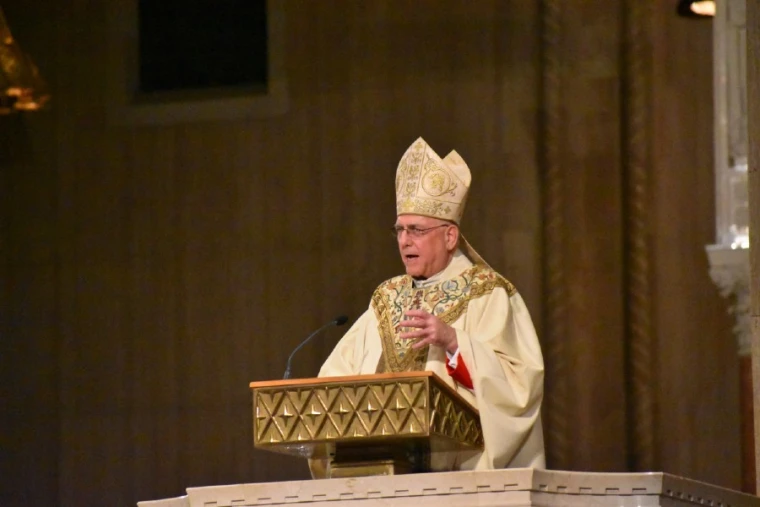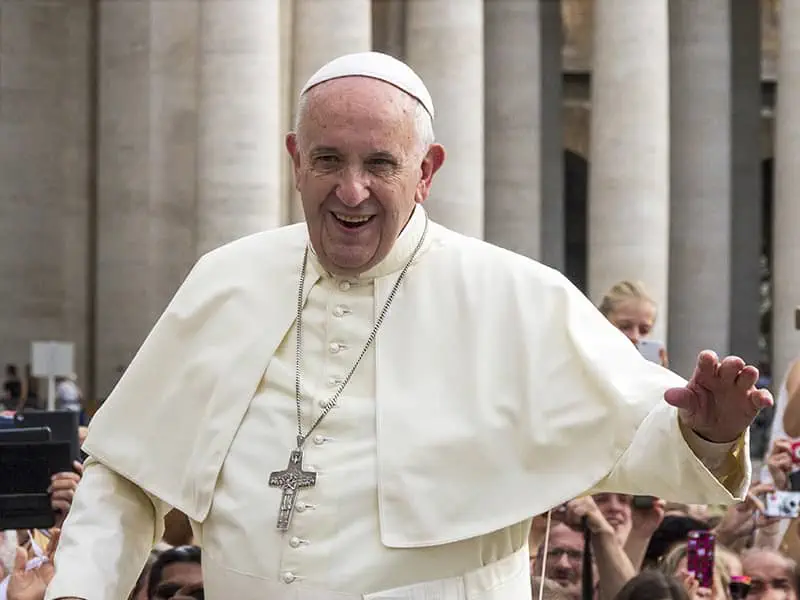Assumption of Mary and Its Relevance Today
by Francis Anekwe Oborji
“… When Elizabeth heard the greeting of Mary, the baby leaped in her womb, and Elizabeth was filled with the Holy Spirit and she exclaimed with a loud voice, ‘Blessed are you among women, and blessed is the fruit of your womb!’ And Mary said: My soul magnifies the Lord, and my spirit rejoices in God my savior, for he has regarded the low estate of his handmaid. For behold, henceforth all generations will call me blessed; for he who is mighty has done great things for me, and holy is his name.” (Luke 1.41-49).
Every year, on August 15, Catholics all over the world celebrate the Feast or rather Solemnity of the Assumption of Blessed Virgin Mary, Mother of Christ into Heaven. The Feast of Assumption, always celebrated from the apostolic era, both in the East and West, of the then known Christian world, became a dogma of the Church on November 1, 1950, following Pius XII’s Apostolic Constitution, Munificentissimus Deus (M.D.).
Although the Scriptures are silent about Mary’s death, Ancient Traditions of the Church right from the Apostolic Times had always recounted and celebrated the story of the Assumption of the Blessed Virgin into Heaven, however, in an informal way. Thus, from the Patristic Era and especially, during the early ecumenical councils of the Church Fathers, most theologians thought it inappropriate that the body that had given flesh to Christ should have been allowed to decay in the grave. Therefore, on the basis of ancient traditions, Mary’s Assumption and her Immaculate Conception were widely believed, though not declared dogmas until later dates by the Popes. The Assumption regarded as necessary because Mary had been elevated above sinful humankind, and therefore, should not know decay after death.
The Assumption of Blessed Virgin Mary into Heaven, believed and celebrated from the earliest times in the East, was also widely accepted in the West, although it was not an official dogma until 1950. In the Apostolic and Patristic Eras of the Church, both in the East and West, the celebration of the feast of Assumption grew alongside devotion to the triumphant Mary, Queen of Heaven, who was portrayed as seated on a throne alongside her Son. In other words, the dogma of Assumption of Mary in 1950, was only a way of giving an official recognition of what was already an accepted tradition and celebration in the Church from the earliest times.
Our aim in the present article is to highlight the significance and relevance of the Feast of Assumption for Christians and the world in general today. What is the relevance of the Feast of Assumption for our conflict-inflicted society, suffering also from the scourge of the deadly COVID-19 Coronavirus pandemic? Has the Feast of Assumption anything to tell us about how to discern and address the present crisis bedevilling the society and our individual lives?
Assumption of Mary in Historical Perspective
There is a story of a Muslim mother, who pardoned the killer of her son by a symbolic gesture of slap on the cheek of the killer on the day of execution.
What is the significance of this story to our reflection on the Feast of Assumption of Mary into Heaven? The story may be a fitting introduction to what we are about to say concerning the drama of the Passion and Crucifixion of Jesus Christ, the central moment of the Passion itself, and where the Blessed Virgin Mary is inserted into the drama.
In the first place, let us begin with a brief allusion to the origins of the Feast of Assumption.
According to Tradition of the Church, the Apostle John, to whom the Lord Jesus Christ on Good Friday, from the cross, charged to take care of the Blessed Mother Mary, began to live with her in his house in the ancient City of Ephesus (cf. John 19:25-27). From there, when it became obvious that the time for her earthly sojourn was approaching, John sent message to the brethren in other parts of the world to come to Ephesus and bid farewell to the Mother of the Savior.
In the presence of the Christian community at Ephesus and others from far and near, Blessed Virgin Mother breathed her last. From there, she triumphantly, was “Assumed” into heaven. Since that period onwards, the Church has been commemorating the triumphant entry (Assumption) of Blessed Virgin Mary into Heaven. This is the origin of the Feast of Assumption.
In the East where this event took place, the Church there had been commemorating the Feast of Assumption from time immemorial. It later spread into the West and became dogma only in 1950. Today, at the ancient City of Ephesus, the house of John, where Mary lived, is a popular Pilgrimage Center. In other words, the faith of the Church in the story of Assumption of Mary is a very solid one, indeed.
The Tradition also confirms the biblical testimony of what happened on Good Friday when Jesus handed over His Mother Mary to the Apostle John. In the Gospel of John, we read:
“Standing by the cross of Jesus were his mother … When Jesus saw his mother, and the disciple whom he loved standing near, he said to his mother, ‘Woman, behold, your son!’ Then he said to the disciple, ‘Behold, your mother!’ And from that hour the disciple took her to his own home.” (John 19:25-27).
The above biblical testimony of John has one major implication for our understanding of the significance of Assumption of Blessed Virgin Mary into Heaven. It tells us how Blessed Virgin Mary was inserted into the central moment of the Passion of Jesus Christ. In the same context, it tells us where and, in whose house,, the Blessed Mother ended her earthly existence before being ‘assumed’ into Heaven.
With regard to the first point, the Blessed Mother Mary was inserted into the drama of the Passion of Jesus Christ at the most crucial moment of that event. This was the moment of reciprocal love, in which all those involved in the Passion of Jesus Christ, witnessed the consummation of it all at the Golgotha. Apart from the other two women, Mary the wife of Clopas, sister of Blessed Virgin Mary, and Mary Magdalene, at the foot of the cross, on Good Friday, before he breathed last, were his mother, Blessed Virgin Mary, and John the Evangelist, who described himself as the disciple the Lord most loved.
In other words, Blessed Mother Mary is inserted into the drama of the Passion of Christ at that moment of the reciprocal love, in which all those involved in the Passion, witnessed the consummation of it all under the cross. As one author put it: “It is a moment in which Christ don’t feel any longer the Son or the Father, the Father of Jesus, etc., because Christ has now submitted to the Father’s plan, by accepting death on the cross.” (The consummation of it all on the cross).
In this case, Blessed Virgin Mary, is involved in this mystery, and so she does not now feel just the “Mother” of Jesus, but the “Mother” of God (Theotokos). It now becomes clearer to Blessed Virgin Mary that in Jesus Christ, she ‘generated’ God, the Creator of heaven and earth. She now begins to understand clearly, that she is indeed Mother of God, that Jesus Christ, whom she had generated as the fruit of her womb, is indeed God and Savior of humankind.
In fact, of all who were there on that Good Friday under the foot of the cross, our Blessed Mother Mary was the only one qualified for the grace of the beatific vision. We should not forget that she was the only one under the foot of the cross on that Good Friday who had been clothed already with the gift of the Holy Spirit (Luke 1:34-35). The rest, including the Apostle John and the two Marys, were to wait until the day of Pentecost to receive the gift of the Holy Spirit (Acts 2).
Therefore, what happened on the cross on Good Friday was a ‘kind of beatific vision’ to the Blessed Virgin Mary. The Triune God was revealed to her, so to say. Mary began to experience and know the inner-life of God, Father, Son and Holy Spirit. This revelation was the fruit of Mary being the Mother of Jesus Christ, the gift of her Immaculate Conception and, especially, the gift of the Holy Spirit she received on the day of Annunciation (Luke 1:26-38).
All this implies that the Blessed Mother Mary started to live beatific vision and as the Queen of Heaven, ever before the end of her earthly existence. Her Assumption into Heaven, therefore, was only a confirmation of what God has done in the life of His ‘Handmaid’, the Blessed Virgin Mary.
The Dogma of Assumption: An Appraisal
As noted, before, in the Apostolic Constitution, Munificentissimus Deus (M.D.), Pope Pius XII solemnly defined Mary’s bodily Assumption into Heaven as dogma of faith. He did this in the following words:
“We pronounce, declare, and define it to be a divinely revealed dogma: that the Immaculate Mother of God, the ever-Virgin Mary, having completed the course of her earthly life, was assumed body and soul into heavenly glory.” (Pius XII, Apostolic Constitution, Munificentissimus Deus).
The dogma of her Immaculate Conception, Motherhood of God, and Perpetual Virginity, are all contained in the subject of this definition. By using the phrase, “… having completed the course of her earthly life …, “, Pius XII clearly indicated his intention of leaving open the theological and historical question of whether or not Mary actually experienced death before being taking up into glory. “… was assumed …” signifies that Mary, a mere creature redeemed by her Son, was “taken up” into heaven by divine power, and did not “ascend” as Christ did through that power within him.
The mystery of Assumption is quite distinct from that of Christ’s Ascension. Again, “… body and soul…” means that Mary has been glorified in her total personhood, and does not define a dualistic anthropology as the Church’s official teaching. And finally, “… into heavenly glory”, refers to the mysterious mode of existence beyond the limits of space and time in the intimate presence of the triune God and our Risen Lord.
The various aspects of this mystery are to be found in related doctrines of the Church about general eschatology, particularly the beatific vision and bodily resurrection of all the just. It's essential meaning, as outlined above, can be accepted only by the grace of the divine faith.
In the “Catechism of the Catholic Church” (CCC), we read: “Finally the Immaculate Virgin, preserved free from all stain of original sin, when the course of her earthly life was finished, was taken up body and soul into heavenly glory, and exalted by the Lord as Queen over all things, so that she might be more fully conformed to her Son, the Lord of lords and conqueror of sin and death. The Assumption of the Blessed Virgin is a singular participation in her Son’s Resurrection and anticipation of the resurrection of other Christians.” (CCC no. 966).
In the teaching of Pope Paul VI, cited in the CCC, we read, “We believe that the Holy Mother of God, the new Eve, Mother of the Church, continues in heaven to exercise her maternal role on behalf of the members of Christ” (CCC no. 975).
The CCC quotes an ancient hymn of the Byzantine Liturgy on the Feast of Assumption: “In giving birth you kept your virginity; in your Dormition you did not leave the world, O Mother of God, but were joined to the source of Life. You conceived the living God and, by your prayers, will deliver our souls from death” (CCC no. 966).
St. John Damascene, described by Pope Pius XII as the interpreter par excellence of the dogma of Assumption, has this to say, “It was fitting that she who in giving birth had preserved her virginity unspotted should keep her body incorrupt even after death. It was fitting that she who had borne the Creator as a child in her bosom should have a dwelling-place with God. It was fitting that the bride espoused by the Father should dwell in the bridal-chambers of heaven. It was fitting that she who had gazed on her Son on the cross, receiving then in her breast the sword of sorrow she had been spared at his birth, should behold him seated with the Father. It was fitting that the Mother of God should enjoy the privileges of the Son and should be honored by all creation as the Mother and the handmaid of God.” (St. John Damascene, on the Assumption of Blessed Virgin Mary into Heaven).
St. Germanus of Constantinople sees the translation of Blessed Mother Mary’s incorrupt body as fitting in, not only with her divine motherhood, but with a special sanctity which attaches to its virgin state.
According to Pius XII, in the Apostolic Constitution, Munificentissimus Deus, all the Church Fathers who commented based their conclusions on the Bible, which has given us the picture of our Lord’s Mother as inseparably attached to her divine Son, and constantly sharing his lot.
In fact, from the second century onwards, the Blessed Mother Mary has been identified by the Fathers of the Church as the second Eve. Not on the same level, indeed, as the second Adam, but intimately associated in his warfare against the enemy of our human race. It was to issue, as it were, from the promise made in paradise, in a complete triumph over sin and death, those twin enemies that are so often coupled together by St. Paul. In the words of Pius XII, “Of this victory, our Lord’s resurrection is the operative part, the supreme trophy; but our Lady, too, who shared in the conflict, must share in its conclusion, through the glorifying of that virgin body of hers. Only then, as the apostle says, ‘when this mortal nature wears its immortality, the saying of scripture will come true, death is swallowed up in victory.”
Assumption of Mary and Its Relevance Today
Here comes the challenge of the message of Assumption of Blessed Virgin Mary and its actuality today:
It means that what our society needs today, is the gospel of love. It is the injunction of self-giving in love for the good of greater majority as exemplified in the life of Jesus and His giving of His Holy Mother Mary to be with the Apostles and the Church, until they receive on the Pentecost day, the gift of the Holy Spirit.
Therefore, the implications of the Feast of Assumption to the crisis of different forms and shapes which we live today in the society, be it political crisis, violence, terrorism, wars, conflicts and and the present crisis of COVID-19 Coronavirus pandemic, etc., could all be located within that drama of the Good Friday Passion. It is the height of the Jesus demonstration of God’s love for humanity and the world.
We carry and bear our daily cross, with love, patience and perseverance in our faith in Jesus Christ, knowing fully well that after Good Friday, comes the Easter Sunday of the Resurrection. Crisis and trials of life do not have the last word, the love of God through the Crucified Jesus, do.
The Feast of Assumption makes present to us in a very special way, the drama of the Good Friday Passion. This can be gleaned from the passage of the Gospel of John, that is, when Jesus said to the Apostle John: “Behold, your mother! And from that hour the disciple took her to his own home.” (John 19:27).
What this means in effect, is that none of those who witnessed the Good Friday Passion drama remained as before, beginning with Christ himself (John 18). The Blessed Virgin Mary who generated God in Jesus Christ, is now given to the Church and all believers in Christ as their Mother; and they, as her children. She who generated God is now to generate children for God in the Church founded on the faith of the Apostles by Jesus Christ.
Moreover, in the case of John taking care of the Blessed Mother, it means that, Christians are those invited to generate God, as the Blessed Mother Mary. Here it is important that we distinguish ‘generating’ from such expressions as, ‘governance, management or administration.’ Generating means ‘generating people for God.’ It is living a life of ‘love of my neighbor’ through which one can, following the gospel teaching, begin to “generate people” for God.
What is important, however, is that which saves us, otherwise, we fall into ideology. What is important is that which generates life: life of Christ in people, in which one becomes sacrament of Jesus Christ before the people, generates life of Christ in them and in the society in which one lives.
Furthermore, Blessed Mother Mary living with John, and therefore, the Apostolic Church, points to the continued presence of Christ in the community of believers through His Mother Mary, as they await the coming of the Holy Spirit on the Pentecost day. Again, Mary was the only member of the Apostolic Church before the Pentecost, clothed already by the Holy Spirit on the Annunciation day (cf. Luke 1:35-38). The rest are yet to receive the gift of the Holy Spirit.
Moreover, having the Blessed Mother Mary live with them, means for the Apostles and early Christians, living the life of togetherness as Christ lived, and as the sacrament of the Trinitarian love. This is the life the Church is called to live at all times. It is the life every Christian is as well, invited to live (cf. Acts 1:14; 4:32-35).
In other words, the Blessed Mother Mary, at moment of the Passion of Jesus Christ, and thereafter, in the community of believers in the early Church, began to live the experience of the Paschal Mystery. She gives light of humanity to God and of God to humanity. She becomes the Mother of God and the Mother of the Church.
Here, we meet the uniqueness of Mary’s love for God and humanity: The love, greater love, is to love your neighbor, your brothers and sisters as you have loved yourself. It is not so much the intensity of love, but that I live my life to give my life for the other. That is, to put myself on the part of the other. If you want to be consoled, you do it for others. This is in line with the gospel injunction: “love your neighbor as you love yourself.”
If for example, we live in Nigeria today on the basis of our ethnic and religious biases, and those in corridors of power follow that principle of biases – lopsided government, ethnic-hate and religious bigotry, there is no way citizens can learn to appreciate one another beyond individual’s ethnic configuration. There is no way the country itself will make meaningful progress in any facet of human development either.
Thus, the Feast of Assumption and its significance is not so much about how we are to overcome suffering, but something already overcome for us in Christ. That is, overcoming hatred of the other, which Christ has already overcome for us on the cross. It is about overcoming the barriers of ethnicity, racism, religious bigotry and hatred. It is about living a new life shaped by love of God and neighbor, not my racial, ethnic or religious configurations.
The Feast of Assumption is about the meeting of the Gospel of Love and the created reality, which includes our racial, ethnic and religious differences. In other words, the experience of the Gospel and its teaching on love put us in relation with God, beyond the limitations of the present reality. Sometimes, our narrowness and attachment to our racial, ethnic, and religious biases or interpretation of that reality can become an obstacle to entering into the life of love of God and neighbor with universal horizon and objectivity.
Conclusion
All this invites us to life of conversion and revisiting of our priorities in life. The Feast of Assumption invites us to put the ‘love of my neighbor’ – indeed human person at the center, and in whatever one is pursuing in life. Selfishness, racial hatred, ethnic-hate, religious bigotry, violence, lopsided regime, autocracy, corruption, etc., are antidotes to the ideals of the Gospel teaching on love of neighbor. They are opposite to the example of life lived by the Blessed Mary. The life which merited her to be called the Mother of our Savior and Redeemer Jesus Christ, and for which we celebrate today her “Glorious Assumption” into Heaven, which took place from her place of abode with the Apostle John in the Biblical city of Ephesus.
Therefore, one of the major challenges of the Feast of Assumption for us today is its message of self-giving and of love of neighbor. It is by embracing such ideals that we can begin a new chapter in our individual lives as well as in the work of rebuilding our society or country. That is, of rebuilding our society as a place where every citizen will feel belonged and proud to call his/her home, without feeling discriminated against because of his/her color, ethnicity, religion or philosophical persuasion. Today, as we speak, our society as structured and governed, is very far from these ideals, and therefore, far from the gospel teachings on self-giving and ‘love of my neighbor.’
All we need today in our society, is to put the human person first – ‘the love of my neighbor as I love myself.’ That is, to follow the example of Jesus Christ, “… Who though he was in the form of God, did not count equality with God a thing to be grasped, but emptied himself, taking the form of servant, being born in the likeness of men. And being found in human form he humbled himself and became obedient unto death, even death on a cross” (Philippians 2:6-8).
This is the type of conversion the Feast of the Assumption of the Blessed Virgin Mary, invites us to embrace. The type of conversion that will lead us all to love of neighbor and self-giving for the greater good of the entire society. ‘Mary gave God humanity to be born in human flesh. By our self-giving in love for greater good of the society, we are participating in generating life for God, as Blessed Mary did.’
The Feast of Assumption invites us to love our neighbor, the other person, irrespective of our differences in skin-color, ethnicity, religion and philosophical persuasions. The Feast of Assumption challenges us to see power as selfless service, not as an opportunity for vendetta, personal enrichment, or racial, ethnic and religious manipulations through government machinery and social system operative in the society.
Rev. Fr. Prof. Francis Anakwe Oborji writes from Urban University Rome















.jpg)
.jpg)
.jpg)
.jpg)